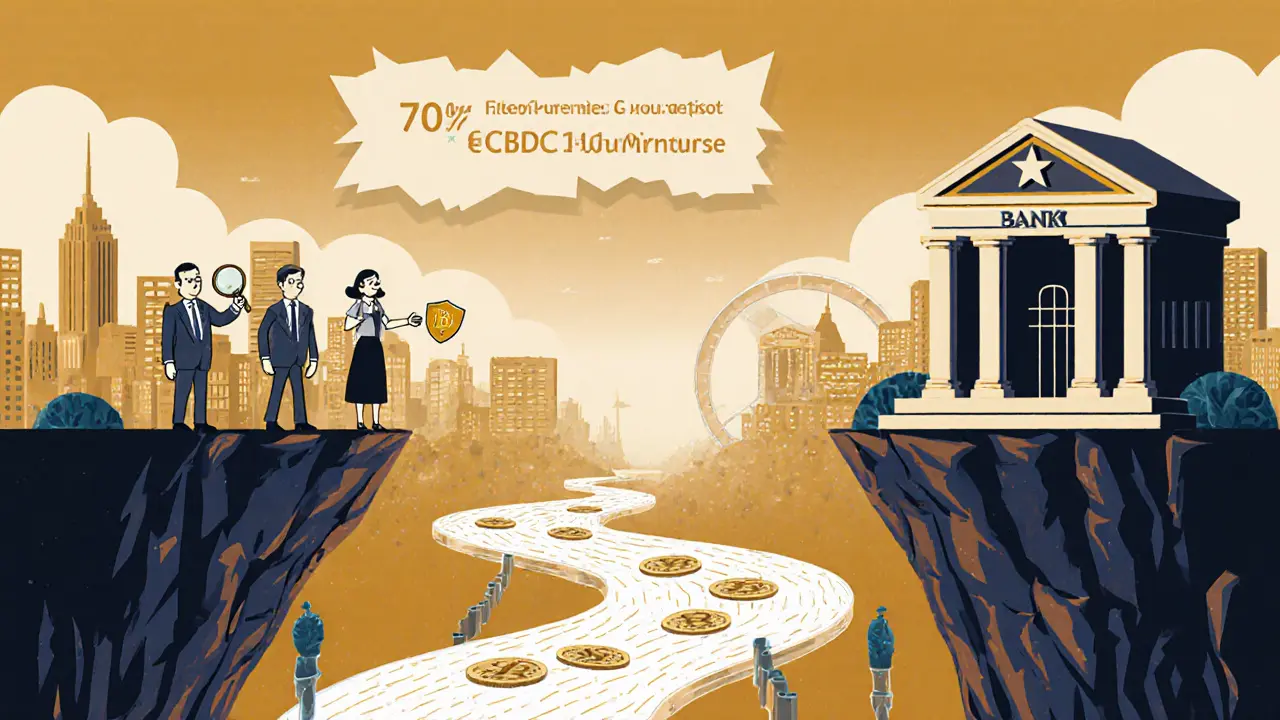How CBDCs Will Reshape Traditional Banking by 2030

Oct, 29 2025
CBDC Deposit Impact Calculator
See how much bank profits could decline as customer deposits move to Central Bank Digital Currencies. Based on data showing 12-15% profit loss for every 10% deposit loss.
By 2030, your bank account might look nothing like it does today. Central Bank Digital Currencies (CBDCs) aren’t science fiction-they’re already live in China, the Bahamas, and over a dozen other countries. And they’re not just another app or digital wallet. They’re the government’s version of cash, but digital, traceable, and backed directly by the central bank. Unlike Bitcoin or Ethereum, CBDCs aren’t decentralized. They’re the exact opposite: controlled, monitored, and issued by the same institutions that print your paper money. And that changes everything for traditional banks.
CBDCs Are Already Eating Into Bank Deposits
Right now, banks rely on customer deposits to lend money. That’s how they make profits-take your savings, lend it to businesses or homebuyers, and keep the difference. But CBDCs offer something banks can’t: a risk-free, government-backed digital savings account. In Germany, a BIS survey found that 67% of people would move some of their deposits to a digital euro during normal times. During a bank crisis? That number jumps to 82%. Imagine if half your customers suddenly pulled their money out and put it into a digital wallet issued by the central bank. Banks wouldn’t just lose deposits-they’d lose their main source of funding.That’s called disintermediation. And it’s not theoretical. China’s digital yuan has already reached 260 million users. In the Bahamas, 35% of adults use the Sand Dollar daily. These aren’t niche experiments-they’re scaling fast. And when people start using CBDCs for everyday payments, they stop needing traditional bank accounts for simple transactions. That’s a direct hit to the core business model of banks.
Why Banks Can’t Compete on Speed or Cost
Banks still handle payments through systems like SWIFT, RTGS, or NEFT. These are slow, expensive, and often require intermediaries. CBDCs, by contrast, settle in seconds, 24/7, with near-zero fees. FTI Consulting found CBDC transactions are faster and cheaper than any existing system. When you can send money to your neighbor in real time without a middleman, why pay $5 for a wire transfer? Why wait three days for a check to clear?Traditional banks built their reputation on trust and infrastructure. But now, the government is offering the same trust-plus better tech. And it’s not just about payments. CBDCs can be programmed. Imagine if your rent payment automatically deducted on the 1st, or your child’s allowance was capped at $20 per week. That’s not possible with your current bank account. CBDCs can do it. And that’s a feature banks can’t easily copy.
CBDCs Will Lower Bank Profits-By Up to 15%
It’s not just about losing deposits. It’s about losing income. When banks lose deposits, they lend less. The CEPR study in 2025 showed that a 10% drop in bank deposits leads to an 8-10% reduction in business lending. That means fewer loans for small businesses, fewer mortgages, and less economic activity. And banks? Their profits drop by 12-15% on average.Here’s the twist: households benefit. With CBDCs, banks are forced to compete harder for the deposits they still have. In competitive markets, deposit rates rose by 0.35 percentage points on average. That’s good for savers. But for banks? It’s a squeeze. They’re earning less on loans and paying more on deposits. Their margins are collapsing.

The Privacy Paradox: Surveillance vs. Inclusion
One of the biggest debates around CBDCs is privacy. In the U.S., 91% of Reddit users in r/CBDC expressed fears about government surveillance. In Europe, it’s 67%. People worry: if every transaction is recorded, can the government track your spending? Can they freeze your account? Can they block payments to certain businesses?But in emerging economies, the story is different. In Brazil, 85% of financial professionals see CBDCs as a tool for inclusion. Over 1.7 billion adults worldwide still don’t have bank accounts. Many live in rural areas with no physical branches. A digital wallet on a basic phone? That’s life-changing. The digital yuan in China has reached people in remote villages who’ve never seen a bank teller. The Sand Dollar in the Bahamas lets fishermen get paid instantly without waiting for checks to clear.
There’s no easy answer. CBDCs can empower the unbanked-or they can become tools of control. The design matters. The BIS recommends a €3,000 per household limit on CBDC holdings to prevent mass bank runs. That’s a smart compromise: enough for daily use, not enough to destabilize the banking system.
How Banks Are Fighting Back
Banks aren’t sitting still. Some are already adapting. In India, 45% of pilot banks offer cashback incentives for using the digital rupee wallet. In the EU, 32% are creating investment products tied to CBDC balances-think interest-bearing digital savings accounts that pay more than the central bank’s rate. U.S. regional banks are testing credit lines based on CBDC holdings, using blockchain data to assess risk.But it’s not easy. Banks need new tech, new skills, and new regulations. The RBI found that 76% of banks struggle with integrating CBDC systems. Only 15,000 blockchain experts exist worldwide. And documentation? China’s digital yuan has developer reviews at 4.3/5. The European digital euro? Just 3.1/5. Banks are playing catch-up.
The smart ones are shifting focus. They’re moving away from being payment processors and becoming financial advisors. They’re offering wealth management, business loans, insurance, and complex financial products-things CBDCs can’t do. CBDCs handle money movement. Banks handle money meaning.

The New Financial Landscape by 2030
By 2030, the banking world will look like this:- CBDCs will handle 70-80% of retail payments-banks will be sidelined for simple transfers.
- 30-40% of current bank deposits will have moved to CBDC wallets.
- Central banks will directly influence interest rates through CBDC yields, cutting out bank intermediaries in monetary policy.
- Traditional banks will focus on lending, advisory, and complex financial services-where they still have an edge.
- Big tech and digital-only banks will keep growing, but CBDCs will become the underlying infrastructure everyone builds on.
The $120 trillion global banking industry won’t disappear. But it will shrink-and transform. Banks that treat CBDCs as a threat will lose. Those that see them as a tool will survive. The winners will be the ones who stop trying to compete on payments and start competing on trust, advice, and personalized service.
Will CBDCs Replace Banks Entirely?
No. Not even close. Dr. Diego C. Nocetti says CBDCs might replace commercial banking. But he’s an outlier. Most experts agree: CBDCs will take over payments. Banks will take over relationships.Think of it like this: The post office delivers mail. But you still go to a financial advisor to plan your retirement. The CBDC is the post office. The bank is the advisor. One moves money. The other helps you use it wisely.
China and the Bahamas didn’t kill their banking systems-they redefined them. Banks there now focus on credit, wealth, and risk. That’s the future everywhere. CBDCs aren’t the end of banking. They’re the end of banking as we knew it.
Are CBDCs the same as Bitcoin or Ethereum?
No. Bitcoin and Ethereum are decentralized cryptocurrencies-no government controls them, and their value swings wildly. CBDCs are digital versions of your national currency, issued and backed by your central bank. They’re stable, like cash, but digital. If you hold a digital yuan, it’s worth exactly one Chinese yuan-no more, no less.
Can the government freeze my CBDC account?
Technically, yes. Since CBDCs are issued by the central bank, they can be programmed to restrict transactions. For example, funds could be blocked for illegal activity, or payments could be limited to certain categories like alcohol or gambling. But most central banks are designing CBDCs with privacy safeguards. The European Central Bank, for instance, plans to allow anonymous small-value transactions. The real risk isn’t the tech-it’s the policy choices governments make.
Will my bank go out of business because of CBDCs?
Not if they adapt. Banks that still focus on payments and basic accounts will struggle. But banks that shift to advising, lending, and managing complex finances will thrive. Your local bank might lose your savings account, but it could still give you a business loan, help you invest, or protect your assets. CBDCs handle money movement. Banks handle money meaning.
How fast will CBDCs spread?
Faster than you think. China and the Bahamas already have live systems. The European Central Bank is targeting a 2027 launch for the digital euro. India’s digital rupee has over 1.2 million users and 5.7 million transactions. By 2030, 15-20% of all retail payments globally could be made through CBDCs. Adoption is accelerating because the old systems are outdated, expensive, and exclusionary.
Do CBDCs threaten the U.S. dollar’s global dominance?
Yes, potentially. Right now, 59% of global reserves are held in U.S. dollars. But if countries like China, the EU, or India launch widely adopted CBDCs, they could reduce reliance on the dollar for international trade. Digital currencies make cross-border payments faster and cheaper without needing U.S. banking intermediaries. The International Banker predicts the dollar’s share could drop to 45% by 2035 as digital alternatives gain traction.